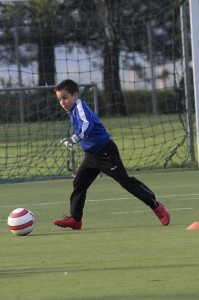It’s often said that the man “off” the ball plays the ball. Believe it or not, this makes a lot of sense. If you put a world class player on a poor team he’ll likely struggle. Every player requires help and if his teammates aren’t running into the right space at the right time then passes can’t be made and possession of the ball will be lost. Players who are willing to make unselfish runs to create space for other players are very valuable to a team. 
To practice the art of running off the ball here’s a simple exercise. It might be easiest to demonstrate this to your players with the help of an assistant. Play the ball to a partner from about 15 yards, then sprint forward and diagonally across the front of him. He fakes to play the ball through to you, and then suddenly moves off in a sprint with the ball away from where you have run. Basically, you’re acting as a decoy for him by drawing away imaginary opponents. To repeat, he then plays the ball to you, and he goes off on a decoy run while you move off with the ball.
Next, introduce a defender. Play two players against one, with you marking one player who has a sup¬porting player about 15 yards away. The ball is played to the player you’re marking. He plays it off to the supporting player and runs about four yards wide. The supporting player then runs at you. As he is running at you, the player off the ball sprints around the back of you calling for a pass. Notice that now your attention is attracted by this run and you can’t concentrate entirely on the man running at you.
The man in possession now has a better chance to take you on and get a shot on goal. But the decoy run is of no value unless the decoy man makes the defender think he wants the ball. The run must also be timed so that if the man with the ball wants to use the runner he can. With practice you’ll be able to perform this so that if you wanted to play the ball through, the decoy runner would be on side.
Young players, of pee wee to middle school age, might have trouble grasping the idea of decoy work and even the concept of playing off the ball. Through the exercises described in this article your preschool to kindergarten age players will gradually begin to realize that play without the ball directly affects the play of the player who does have the ball at the moment. Soccer is a sport in which everyone on the field is connected and working together whether they have the ball or not.
Free-kicks give you an excellent opportunity to use decoy work. It gives you good practice to work out movements from “still” positions. One example is a free-kick routine from a position just outside the penalty area. The opposi¬tion might put three players in the wall and their winger might come back to mark your winger. This means your fullback on that side of the field is spare. The winger, on a signal, runs across the front of the wall calling for the ball, attracting the attention of the opposing winger. The ball is then played into the space created by the winger’s movement for the fullback to move into. He can now get at the back of the wall or cross to the near or far post.
Practice this movement and you’ll see that other ideas will come to mind. Once your players begin demonstrating that they understand playing off the ball, you’re on the right track with coaching this concept.


No comments yet.